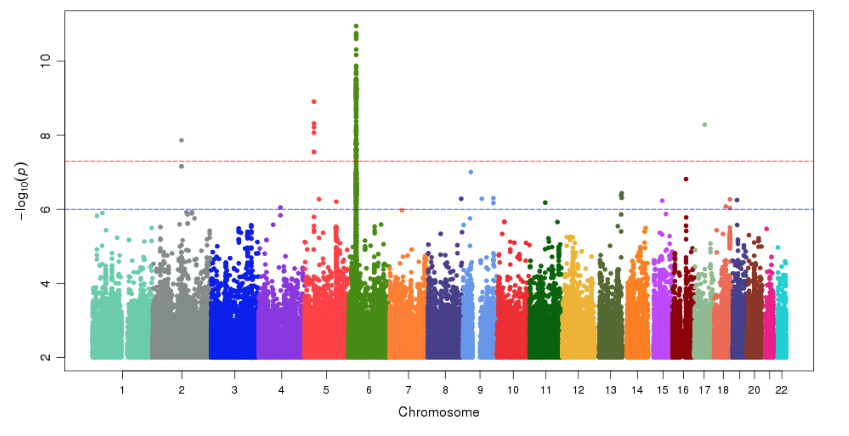Session Information
Session Type: Poster Session B
Session Time: 8:30AM-10:30AM
Background/Purpose: Granulomatosis with Polyangitis (GPA) is a systemic ANCA associated small vessel vasculitis. Prior genetic studies demonstrated a strong association of HLA Class II region with GPA. The literature on the non-HLA risk loci is limited as only the minority of the multiple candidate risk loci were able to be replicated in subsequent studies. The aim of this study is to examine the role of non-HLA genetic risk factors for GPA using the genomic data from UK Biobank cohort.
Methods: Our study utilized the UK Biobank database which has over 820,000 genotyped SNPs with up to 90 million imputed variants for 500,000 volunteers from the general population in the United Kingdom (UK). The genetic information of each participant is linked with their International Classification of Diseases (ICD)-10, procedure and treatment codes. 175 patients with ICD-10 code M31.3 Granulomatosis with polyangitis were included in our study as cases. >95% of the cases had at least one other supporting clinical, treatment or procedural codes related to GPA. Sex, age and ancestry matched control subjects were assigned for each case from the same cohort in a 1:20 case: control study design. Related individuals and individuals with autoimmune diseases associated with secondary vasculitis were excluded. The genome wide association analysis was performed using Plink2 methodology.
Results: We identified a total of 338 SNPs with a genome wide significance level of < 5x10-8 and minor allele frequency of >0.5%. (Figure 1) 329 of the significant variants were located at the MHC Class II region in chromosome 6. Within the MHC Class II locus, the SNP with strongest association was rs1042169, an exonic missense variant found in HLA-DPB1 gene. Multiple other SNPs in strong LD with our top hit were identified in HLADPB2, RING1, MIR219A1, RXRB, RING1 and HSD17B8 loci. Independent SNPs were also identified in the HLADPA1 and COL11A2 loci. Outside of the MHC region, nine SNPs exceeded the threshold for genome wide significance. 7 of those were found in EGFLAM locus in strong linkage disequilibrium with our top hit rs2561807, an intronic variant. Two intergenic SNPs with genome wide significance level were identified in STEAP3 and FZD2 loci, rs6723312 and rs568915088 respectively. (Table 1) Both rs2561807 and rs6723312 demonstrated dose dependence with significantly higher prevalence in homozygotes compared to heterozygotes. (Figure 2)
Conclusion: In this genome wide association study, we confirmed the previously reported association of HLA-DP with GPA and identified EGFLAM, STEAP3 and FZD2 as new genetic risk loci. Further research on the role of non HLA region for genetic susceptibility of GPA is warranted.
To cite this abstract in AMA style:
Hocaoglu M, Mikdashi J, Chen Y, Perry J, Hong C. STEAP3, FZD2 and EGFLAM Are Novel Genetic Risk Loci for Granulomatosis with Polyangitis: A Genome Wide Association Study from UK Biobank [abstract]. Arthritis Rheumatol. 2021; 73 (suppl 9). https://acrabstracts.org/abstract/steap3-fzd2-and-egflam-are-novel-genetic-risk-loci-for-granulomatosis-with-polyangitis-a-genome-wide-association-study-from-uk-biobank/. Accessed .« Back to ACR Convergence 2021
ACR Meeting Abstracts - https://acrabstracts.org/abstract/steap3-fzd2-and-egflam-are-novel-genetic-risk-loci-for-granulomatosis-with-polyangitis-a-genome-wide-association-study-from-uk-biobank/



